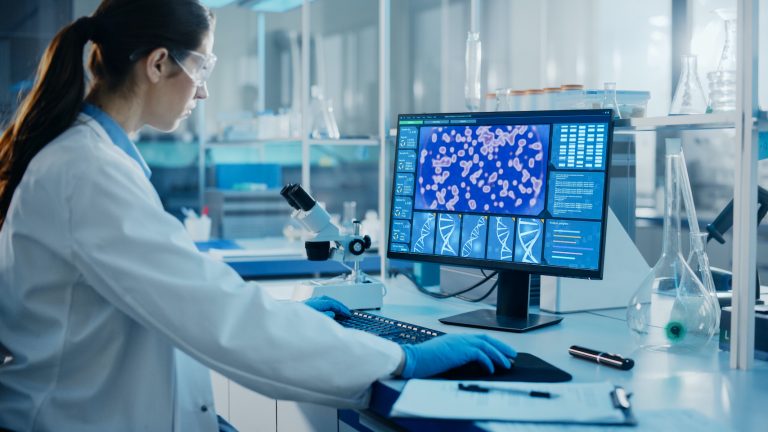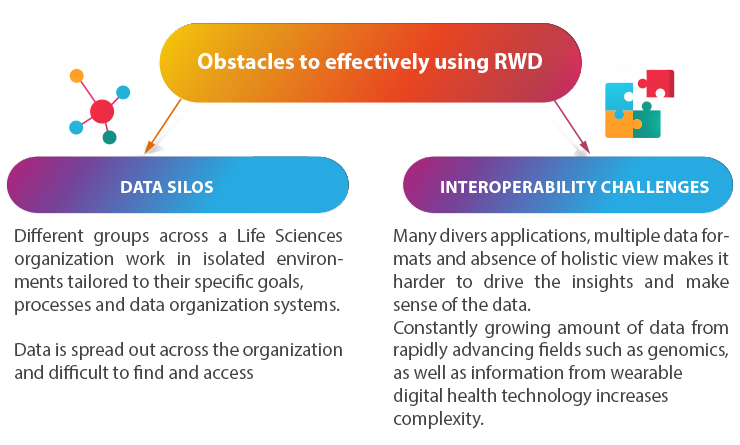We use cookies to enhance your browsing experience, serve personalized ads or content, and analyze our traffic. By clicking "Accept All", you consent to our use of cookies.

The propensity to interpret Real-World Data (RWD) in recent years has provided organizations with a significant advantage in increasingly competitive industries such as Healthcare and Life Sciences. However, despite the opportunities and possibilities that insights from Real-World Evidence (RWE) can facilitate when it comes to higher standards of care and improved patient outcomes, there are also a handful of obstacles that many institutions must overcome in order to truly take advantage of RWE.
The biggest hurdles for most Pharmaceutical and Life Sciences organizations looking to effectively utilize RWD and RWE are data silos and challenges with interoperability. A data silo can be defined as a collection of data held by one individual department or group that is not easily or entirely accessible by other groups within the same organization. Data from different departments is often maintained across a range of platforms, some of which may have initially been built in-house to serve as ad hoc point-solutions. This is due in part to the fact that respective business units have entirely different goals, so the infrastructure and processes they create are often designed with those specific goals in mind. Because of this, internal organizational silos can lead to undefined and inconsistent processes as well as inaccurate or non-standardized data.
In other words, data silos can impact every aspect of the organization. They limit collaboration and communication, take up excess storage space, decrease efficiency, and ultimately slow down the entire business. In fact, communicative restrictions are part of the reason that data silos exist within Life Sciences to begin with. The Healthcare and Life Sciences industries have had a significant number of legacy systems in place for years that were designed to limit the sharing of information to what is strictly necessary. This is of course due in part to the complexity surrounding compliance with HIPPA, PHI, and other data privacy regulations.

Another major obstacle for organizations when it comes to the effective utilization of Real-World Data is interoperability. Challenges with interoperability arise due to the existence of countless applications, various data formats, and the overall absence of a holistic view of the data. This can make it extremely difficult to derive accurate insights or make sense of the data. Furthermore, the amount of data being generated within rapidly growing fields such as genomics as well as the constant stream of information from wearables is increasing at an exponential rate, adding even more complexity to the equation.
Finding the right technology is the first step towards helping organizations overcome these interoperability challenges. Flexibility is key, and it is best achieved through easily configurable systems and microservices. These systems should be integral parts of an overall digital transformation strategy that evolves with the growing amount and complexity of Real World Data as well as the analytics capabilities needed to transform it into RWE. It needs to incorporate automated pipelines for data intake and processing to seamlessly integrate new data and new sources of data, and to rapidly transform them into usable insights.
Creating a solid infrastructure for data storage is also instrumental to overcoming challenges with Real-World Data utilization. This can include using cloud solutions for ease of access and scalability, as well as Data Lakes to accommodate the valuable unstructured RWD from Electronic Health Records (EHRs) and other sources, since unstructured data makes up a significant portion of RWD. Solutions such as Snowflake also exist that can reduce the time and complexity of database maintenance and management. Snowflake offers built-in tools for data transformation and analytics, making Real-World Data immediately usable by a larger number of stakeholders within the organization while effectively eliminating the need for a specialized data science skill set.
The vast majority of Life Sciences organizations stand to benefit immensely from the transformation of RWD into actionable Real-World Evidence. Breaking down the barriers of entry requires overcoming interoperability challenges and thinking beyond the traditional data silos associated with legacy systems in the Healthcare industry, but the promising potential for higher standards of care and better patient outcomes is well worth it.



